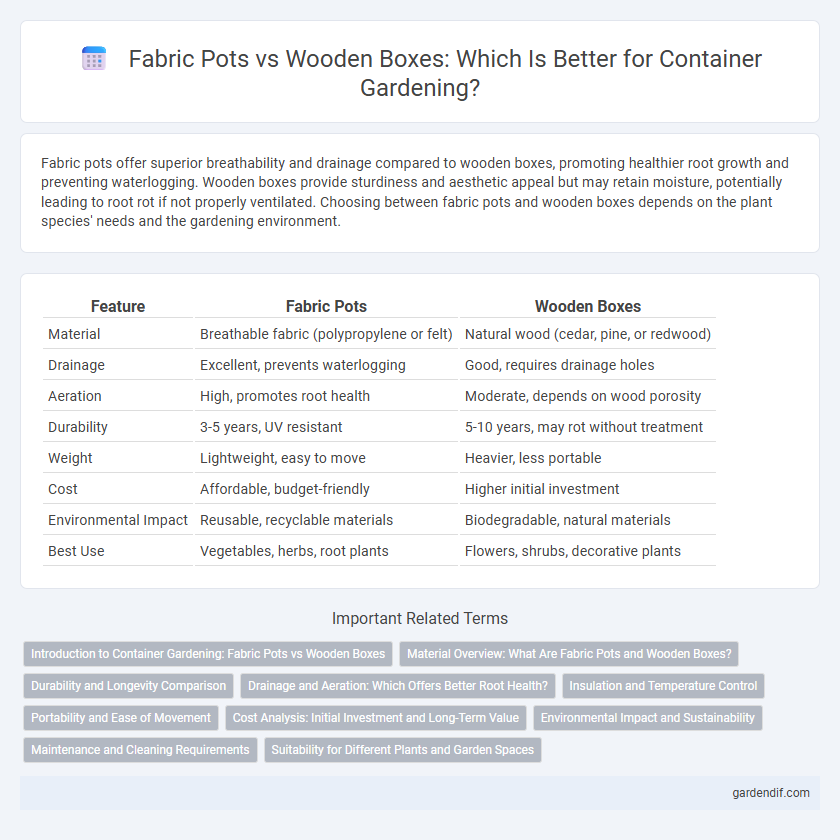
Fabric pots vs wooden boxes Illustration
Fabric pots offer superior breathability and drainage compared to wooden boxes, promoting healthier root growth and preventing waterlogging. Wooden boxes provide sturdiness and aesthetic appeal but may retain moisture, potentially leading to root rot if not properly ventilated. Choosing between fabric pots and wooden boxes depends on the plant species' needs and the gardening environment.
Table of Comparison
| Feature | Fabric Pots | Wooden Boxes |
|---|---|---|
| Material | Breathable fabric (polypropylene or felt) | Natural wood (cedar, pine, or redwood) |
| Drainage | Excellent, prevents waterlogging | Good, requires drainage holes |
| Aeration | High, promotes root health | Moderate, depends on wood porosity |
| Durability | 3-5 years, UV resistant | 5-10 years, may rot without treatment |
| Weight | Lightweight, easy to move | Heavier, less portable |
| Cost | Affordable, budget-friendly | Higher initial investment |
| Environmental Impact | Reusable, recyclable materials | Biodegradable, natural materials |
| Best Use | Vegetables, herbs, root plants | Flowers, shrubs, decorative plants |
Introduction to Container Gardening: Fabric Pots vs Wooden Boxes
Fabric pots offer superior aeration and drainage for healthier root development, making them ideal for container gardening. Wooden boxes provide greater durability and aesthetic appeal, often used for larger plants or outdoor settings. Choosing between fabric pots and wooden boxes depends on factors like plant type, watering frequency, and garden space limitations.
Material Overview: What Are Fabric Pots and Wooden Boxes?
Fabric pots are breathable containers made from woven polypropylene or other durable synthetic materials, designed to enhance aeration and drainage for healthy root growth. Wooden boxes, typically crafted from cedar, pine, or redwood, offer sturdy, natural insulation and protection while retaining moisture for plants. Both options serve different gardening needs: fabric pots prioritize air pruning and root health, whereas wooden boxes emphasize structural strength and traditional aesthetics.
Durability and Longevity Comparison
Fabric pots offer superior aeration and drainage compared to wooden boxes but generally have a shorter lifespan of 3 to 5 years due to material degradation from UV exposure and moisture. Wooden boxes, constructed from rot-resistant lumber like cedar or redwood, can last 10 to 20 years with proper treatment and maintenance, providing enhanced durability in outdoor conditions. While fabric pots are lightweight and flexible, wooden boxes deliver more structural strength and longevity for perennial plantings.
Drainage and Aeration: Which Offers Better Root Health?
Fabric pots provide superior drainage and aeration compared to wooden boxes, promoting healthier root systems by preventing waterlogging and allowing air to circulate freely. The porous nature of fabric pots facilitates oxygen exchange, reducing the risk of root rot and encouraging robust root growth. In contrast, wooden boxes often retain excess moisture and restrict airflow, which can lead to poor drainage and suboptimal root health.
Insulation and Temperature Control
Fabric pots provide superior insulation and temperature control by allowing air to circulate through the breathable material, preventing root overheating and promoting healthier plant growth. Wooden boxes offer moderate insulation with their natural wood fibers, but they tend to retain heat during hot weather, which can stress plant roots. Choosing fabric pots helps maintain a more stable root zone temperature, especially in fluctuating outdoor conditions.
Portability and Ease of Movement
Fabric pots offer superior portability due to their lightweight and flexible material, making them easy to carry and relocate without spillage. Wooden boxes, while sturdy and durable, tend to be heavier and require more effort or tools for movement. The foldable nature of fabric pots also allows for convenient storage and transport compared to rigid wooden containers.
Cost Analysis: Initial Investment and Long-Term Value
Fabric pots generally have a lower initial investment cost compared to wooden boxes, making them an affordable choice for container gardening. Over time, fabric pots offer durability through their resistance to rot and weather damage, reducing replacement frequency and labor costs. Wooden boxes, while often pricier upfront, provide greater structural support and aesthetic appeal, potentially increasing the long-term value of the garden space if properly maintained.
Environmental Impact and Sustainability
Fabric pots offer superior environmental benefits by being reusable, biodegradable, and promoting healthier root aeration, which reduces transplant shock and supports plant growth without additional chemical inputs. Wooden boxes, while natural and biodegradable, often require frequent replacement due to rot and may involve the use of treated wood containing potentially harmful chemicals that impact soil quality. Choosing fabric pots significantly reduces landfill waste and lowers the carbon footprint associated with container production and disposal compared to wooden alternatives.
Maintenance and Cleaning Requirements
Fabric pots require minimal maintenance, as they are breathable and can be easily cleaned by rinsing or hand washing to prevent mold and root rot. Wooden boxes demand more upkeep, including regular sealing or staining to protect against weather damage and prevent wood rot, along with thorough cleaning to remove soil buildup and pests. Overall, fabric pots offer a low-maintenance solution with simple cleaning, while wooden boxes need consistent care to maintain durability and appearance.
Suitability for Different Plants and Garden Spaces
Fabric pots offer superior aeration and drainage, making them ideal for deep-rooted plants and vegetables that require well-ventilated soil. Wooden boxes provide excellent stability and are better suited for larger, established plants or decorative shrubs in garden spaces where structure and aesthetics are important. Both container types accommodate various garden sizes, but fabric pots excel in urban gardening and limited-space environments due to their lightweight and flexible design.
Fabric pots vs wooden boxes Infographic

 gardendif.com
gardendif.com